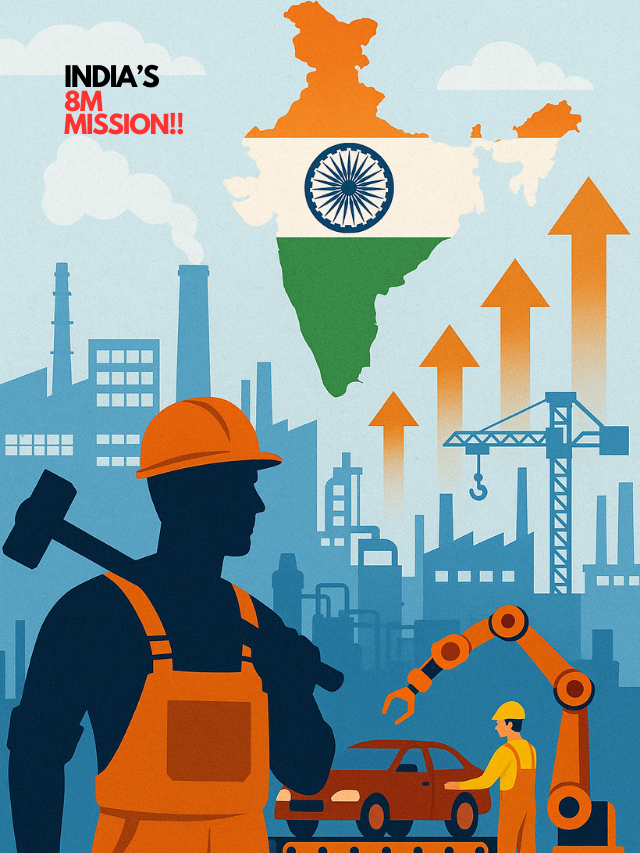SUMMARY
- India must generate 8 million jobs per year for the next 10–12 years to meet its 2047 development vision.
- Boosting manufacturing and MSMEs, while navigating AI disruptions and global trade tensions, is key to growth.
- Chief Economic Advisor (CEA) V. Anantha Nageswaran emphasized policy-driven deregulation and export competitiveness at Columbia India Summit 2025.
“No Easy Answers”: India’s Path to Developed Nation Status by 2047
New York | April 21, 2025 — In a candid address at Columbia University’s India Summit 2025, India’s Chief Economic Advisor V. Anantha Nageswaran laid out the immense economic challenge that lies ahead if the country is to fulfill its vision of becoming a developed nation by 2047 — the centennial year of independence.
“We have to generate at least 8 million jobs per year for the next decade or more,” Nageswaran said. “And raise the manufacturing share of GDP, especially in the post-COVID context where China has consolidated dominance.”
Acknowledging that the external environment is less benign than during India’s earlier growth years (1990–2010), Nageswaran urged a reorientation of domestic economic strategy focused on job creation, MSME development, and manufacturing expansion.
India Must Create 8 Mn Jobs Annually To Realise Its 2047 Development Vision: CEA#ViksitBharat2047 #IndianEconomy #JobCreationIndia #ManufacturingIndia #CEANageswaranhttps://t.co/zibEb2iBIn pic.twitter.com/wPKy40HZxR
— KNN INDIA #MSME (@knnindia) April 22, 2025
Navigating the AI Challenge: Jobs, Technology, and Policy Balance
- Nageswaran warned of AI displacing entry-level and IT-enabled services jobs.
- Emphasized the need to balance labour-centric growth with technology integration.
- Called for public policy leadership, not just technocratic decisions, in managing tech transitions.
Highlighting the disruptive role of artificial intelligence, Nageswaran noted that India’s size and demographics present unique challenges. Unlike developed countries which transitioned during periods of technological stability, India’s transformation must occur in a landscape increasingly shaped by AI and robotics.
“Preparing the population for an AI-dominated world is only part of the equation,” he said. “We also need to maintain policy focus on inclusive growth and human capital development.”
Manufacturing and MSMEs: The Twin Engines of Jobs
- India must raise manufacturing’s GDP share, currently at ~17%, to create scale jobs.
- MSMEs must be plugged into global value chains to ensure growth and competitiveness.
- Countries that became manufacturing powerhouses, he said, “did so on the back of strong SME ecosystems.”
Nageswaran argued that manufacturing and small businesses are inseparable when it comes to driving sustainable employment. He underscored the importance of value chain integration and the need for domestic innovation through exports and competition.
Global Trade Outlook: Lower Expectations, Higher Internal Focus
- Export contribution to India’s GDP growth dropped from 40% in the 2000s to 20% in the 2010s, and could fall further in the 2020s.
- India must invest in quality, R&D, logistics, and last-mile connectivity to improve competitiveness.
- Global capital flows may shrink due to rising geopolitical tensions.
“We cannot count on global trade to fuel growth like it did in the past,” said Nageswaran. “The focus now must shift to domestic deregulation, investment efficiency, and industrial capacity.”
Despite challenges, he remained cautiously optimistic, citing India’s 8% average growth over the past three years. However, he acknowledged that sustaining that figure will be “a tall order” amid global volatility.
“Even 6.5% annual growth, with occasional spurts above 7%, would be enough — if it’s stable, inclusive, and driven by reforms.”
Strategic Priorities: From Investment to Institutional Reform
- India needs either higher investment rates or greater efficiency from existing investments.
- Domestic reforms such as ease of doing business, labour law flexibility, and land reforms must complement trade strategies.
- Policymakers must recognize that technology and geopolitics now influence core macroeconomic strategy.
The CEA emphasized that India’s future lies in policy-led growth, not mere statistical momentum. He pointed to recent deregulation moves as a template for proactive governance in a complex world.
Global Context: India’s Growth Amid Global Slowdown
- UNCTAD forecasts 6.5% growth for India in 2025, bolstered by public spending and easing monetary policy.
- Meanwhile, the global economy is on a recessionary trajectory, driven by trade wars and geopolitical fragmentation.
The Columbia India Summit — hosted by the Deepak and Neera Raj Centre on Indian Economic Policies — brought together policymakers, economists, and students to explore India’s developmental trajectory. Nageswaran’s keynote struck a tone of pragmatism, urgency, and long-term strategic clarity.
Final Word: Vision 2047 Needs Both Jobs and Judgement
India’s path to becoming a developed economy by 2047 will depend not just on GDP growth, but on the creation of quality jobs, supply chain resilience, and the right mix of policy, reform, and readiness for the age of AI.
As Nageswaran concluded:
“There are no easy answers. But there is clarity — and there is resolve. If we stay the course, India can defy gravity, even in a hostile global headwind.”



